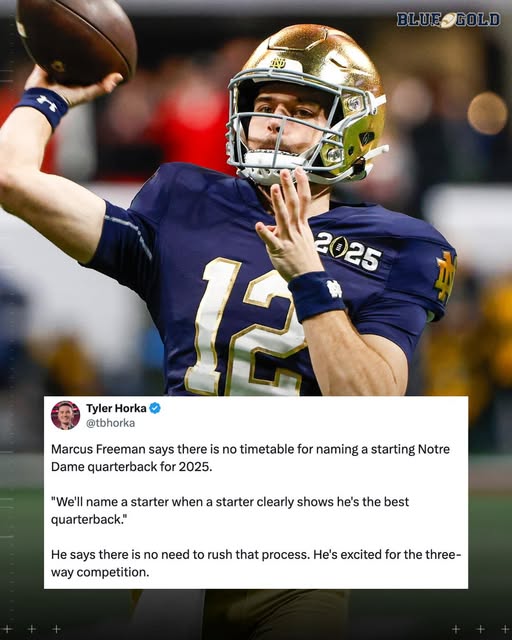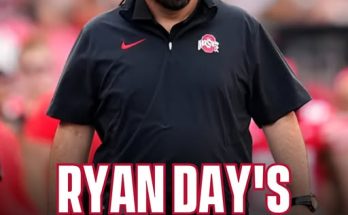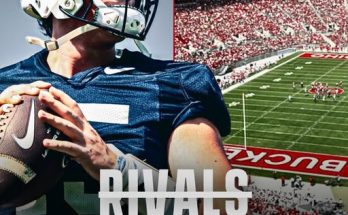When Marcus Freeman took over the reins as head coach of Notre Dame football, he didn’t just inherit one of the most iconic programs in college athletics — he inherited expectations, legacy, and the unrelenting spotlight that shines upon South Bend every fall. At the heart of every collegiate campaign lies one defining decision: the naming of the starting quarterback. For Freeman, that process has not been rushed, reactive, or driven by popular sentiment. Instead, he has implemented a methodical, deliberate, and data-driven approach to selecting the leader of his offense.
But is Freeman’s process the right one?
Let’s unpack what that process looks like, its advantages and challenges, how it has fared in practice, and how it compares to the decision-making frameworks used by other elite programs.
The Marcus Freeman QB Evaluation Philosophy
From the outset, Freeman has emphasized competition, patience, and internal development as the pillars of his quarterback selection strategy. Rather than naming a starter early in spring or letting media hype dictate decisions, Freeman insists on a full body of work — spring practice, fall camp, scrimmages, leadership metrics, and in-game performance — to determine who earns the starting job.
His approach can be distilled into several key principles:
- No Premature Announcements: Freeman avoids naming a starter too early to prevent complacency and ensure fair competition.
- Merit Over Hype: He places greater value on how quarterbacks perform in practice reps and controlled scrimmage settings than on recruiting rankings or past accolades.
- Leadership Qualities: Being a starting QB at Notre Dame is about more than arm talent; Freeman evaluates who commands the huddle, elevates teammates, and responds to adversity.
- Team Feedback: Coaches aren’t the only voices — Freeman has reportedly sought input from position groups, especially offensive linemen and wide receivers, to gauge chemistry.
- Game Readiness: The final decision is also about readiness under pressure. Freeman wants his starter to have the mental toughness to lead under the weight of Notre Dame expectations.
This process is not only holistic, but it also aligns with Freeman’s broader coaching philosophy: accountability, development, and team-first mentality.
The 2023 Quarterback Situation: A Test Case
To understand Freeman’s process in action, let’s rewind to 2023. Notre Dame entered the season with a unique luxury: the addition of veteran Wake Forest transfer Sam Hartman. With 110 career touchdown passes and over 12,000 yards at the Power Five level, Hartman brought experience and polish — yet Freeman didn’t simply hand him the keys.
He still allowed a full competition, encouraging Tyler Buchner and Steve Angeli to push Hartman in practice. While most observers assumed Hartman would start, Freeman waited until fall camp to make it official. The delay wasn’t about uncertainty — it was about trust-building. It showed the locker room that no one, not even a high-profile transfer, skips steps.
Hartman went on to lead the Irish to a 10-win season, throwing for over 2,500 yards and maintaining elite ball security for most of the year. While some games revealed offensive inconsistencies, the quarterback position was largely a strength. The process, in that case, validated Freeman’s method.
2024 and Beyond: The Angeli Era or Transfer Portal 2.0?
With Hartman now departed, the 2024 quarterback decision looms as a defining one for Freeman’s next chapter. Angeli, Minchey, and incoming freshman CJ Carr are among the contenders. There’s also buzz that Freeman could once again dip into the portal if the competition proves inconclusive.
What’s key here is that, once again, Freeman is holding off on naming a starter in spring. That frustrates fans hungry for clarity but speaks volumes about Freeman’s commitment to process over popularity.
CJ Carr, grandson of Michigan legend Lloyd Carr, brings a tantalizing pedigree. But Freeman has no intention of rushing a true freshman onto the field just for narrative. Angeli has been patiently developing, and reports out of early spring practices suggest he’s made significant strides in leadership and timing. Kenny Minchey, meanwhile, offers dual-threat upside.
Instead of picking a favorite now, Freeman is fostering competition, just like he did last year. He believes that the long-term growth of the program is best served when every quarterback feels they have a real shot.
The Pros of Freeman’s QB Process
Freeman’s approach might not be flashy, but it offers several compelling advantages:
1. Cultural Consistency
By not catering to hype or pressure, Freeman reinforces a team culture that values work ethic over entitlement. That’s vital in today’s transfer portal era, where many young QBs expect instant gratification.
2. Locker Room Buy-In
The quarterback room watches how these decisions are made. When they see fairness and transparency, they’re more likely to stay engaged — and stay on the roster.
3. Development Over Panic
Some programs flip quarterbacks mid-season or abandon projects too early. Freeman is more inclined to develop his guys, giving them reps and teaching moments that build long-term value.
4. Strategic Flexibility
Holding off on a decision allows Freeman to make adjustments based on injuries, scheme evolution, or even portal additions. He doesn’t box himself in early.
The Drawbacks and Criticisms
While Freeman’s process is admirable in theory, it’s not without risks or downsides.
1. Media Pressure
Notre Dame fans and national media crave clarity. The absence of a defined QB1 can invite speculation, create distractions, and affect recruiting perceptions.
2. Potential for Splitting Reps
When a competition extends deep into fall camp, quarterbacks may not get enough time with the first-team offense to develop critical timing. Continuity is sacrificed for competition.
3. Transfer Portal Realities
Some young QBs — particularly highly ranked recruits — may grow frustrated with long evaluations and hit the portal. Managing egos in a delayed decision cycle is more complex than ever.
4. In-Game Learning Curve
If a late-named starter struggles early in the season, there’s less time to make changes. And if multiple QBs rotate early, it can stall offensive identity.
A Broader Lens: How Elite Programs Handle QB Decisions
Comparing Freeman’s process with other top-tier programs reveals both similarities and philosophical differences.
At Alabama, Nick Saban has traditionally made late quarterback announcements, waiting until he sees who emerges through rigorous internal competition. That aligns closely with Freeman’s approach.
Georgia, under Kirby Smart, has favored in-house development over splashy transfers (until recently with Gunner Stockton and Dylan Raiola). Smart’s success with Stetson Bennett — a former walk-on turned national champion — echoes Freeman’s emphasis on culture and readiness over star rankings.
Meanwhile, Lincoln Riley at USC has taken a different tack: grab elite transfers and name them starters early. Riley’s QB1 decisions are typically clear by spring, reflecting a more aggressive portal-centric philosophy.
Freeman seems to split the difference — willing to bring in a transfer like Hartman but still insists that no one is above the competition.
The Recruiting Angle
Quarterback recruits closely watch how coaches handle starter decisions. Freeman walks a delicate line. On one hand, his merit-based process can attract players who want a fair shot. On the other, recruits want to see a pathway to early playing time.
How he handles the development of CJ Carr will be crucial. If Carr sits for too long or gets caught in endless battles, it could affect Notre Dame’s ability to land the next five-star.
The challenge is clear: balance patience with modern expectations.
The Verdict: Do We Agree with Freeman’s Process?
Yes — with some nuance.
In a sport increasingly driven by short-term thinking and reactionary moves, Marcus Freeman’s commitment to thoroughness, fairness, and internal accountability is a breath of fresh air. His quarterback evaluation process reflects leadership maturity and a deep understanding of how to build a sustainable culture.
He’s not chasing headlines. He’s building a program.
However, the process must evolve slightly to match the modern realities of college football. That could mean:
- Shortening the window of indecision in years where a clear starter emerges early.
- Improving transparency to keep recruits and fans in the loop without compromising internal dynamics



